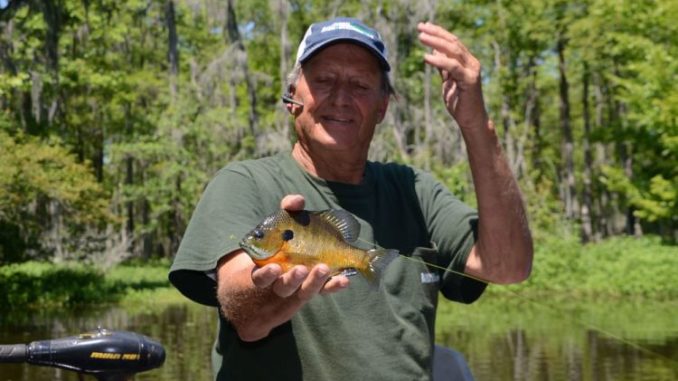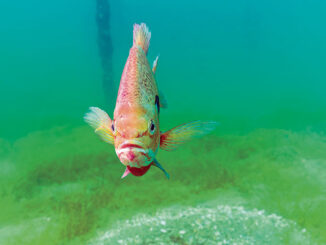
Bream bite best when the sun is up, and Leonard Kleinpeter knows how to catch them. But this is a ‘cricket-free zone’ — here’s how he uses grass shrimp to mop up.
“There’s a good one,” he said, glancing over his right shoulder. “And there’s a good one,” he said, throwing an eye over his left shoulder. “That’s a good one, too,” he nodded at another one.
“Oh hell, they are all good. I don’t know why they aren’t fished more.”
The iron-haired man was Leonard Kleinpeter, at 74 a recognized bream-fishing ace. The “good ones” he was talking about were canals located in the Crackerhead oil field, 25 or 30 of them by his count.
Easy to find, the entrance to the oil field canal complex is located on the east side of Lake Verret, directly across the lake from the impossible-to-miss Shell Beach Landing — the lone camp community located on the lake’s western shore.
While it wasn’t high noon yet, daylight was well advanced when we launched Kleinpeter’s boat in Pierre Part, the small commercial fishing community situated just north of the big lake.
That’s the nice thing about bream fishing. Bream bite best when the sun is on the water. None of that crack-of-dawn stuff. The bream Kleinpeter was after were bluegills, well known for creating spawning beds with one nest almost touching the other.
When you find one big bull bream, the colorful spawning males who guard the nests, you usually find others nearby. Bluegill spawning season begins in May and lasts well into summer.
Kleinpeter’s road trip to Lake Verret didn’t involve a stop at a bait shop. He prefers to catch his own bait, right from the waters of the lake he fishes in.
He always uses grass shrimp for bream bait instead of crickets, the usual standard. “One bite on a cricket and they take it all,” he explained. “And with crickets, sometimes smaller bream nibble around on them.”
After getting his bait, it was off to the races.
Finding the bream
“I always fish Lake Verret for bream,” said Kleinpeter unambiguously. “Not the lake proper. You hear about people catching 150 in one spot in the lake. I guess that I don’t have the patience to find those spots.”
Crackerhead is the name of the bream game for him.
By his own estimate, 90 percent of the bream beds he fishes are located at the very back of dead-end canals. “They love being kind of boxed in,” he said. There are exceptions. His “Old Buddies” spot is located along the side of a canal bank, well away from a dead-end.
Best spots tend to be in the shade of trees rather than in the open sun. Move your bait from spot to spot, completely combing the area, he advised. “If you catch a colorful breeding male, don’t keep moving. Re-bait and throw right back in the same vicinity. Do that until they stop biting.
“Their beds are spots fanned out in the bottom with their fins. They are territorial about their individual spot, but like to build their beds in clusters.”
Fishing tactics
“Approach canal dead-ends carefully. Slow to an idle at least 50 yards out,” Kleinpeter instructed. “At 20 to 30 yards out, begin using a trolling motor for a final approach.
“Keep the boat away from the shallows. Use the full length of the jig pole and line to reach the spots to be fished. Stay seated if at all possible, so that the fish don’t see you. They are in very shallow water and easily scared.”
Kleinpeter uses 3 feet more line than the length of his pole. With one hand on the pole, he uses his other hand to take up the slack and shorten the line, making pole handling less awkward.
On the outswing, he lets the line in his line-holding hand go slack to get maximum distance.
Finally, he coaches to pay attention. “Big bull bream often give a classic bull bream bite—just one tiny twitch of the cork that shows that they picked the bait up and are holding it.
“If you don’t instantly respond, they will swallow the hook and get deep-hooked. That slows down your fishing because you have to dig the hook out of their throat.”
Kleinpeter says that he has taken as many as 80 or 90 bull bream from a single bed, but that 20 is a more typical catch. “If something spooks them and they stop biting, leave and come back in 10 or 15 minutes. You can move back then and catch more.”
Fishing tools
For bream fishing, Kleinpeter exclusively uses 10-foot long graphite jig poles instead of rods and reels. Each pole is rigged with a Mr. Crappie Jigging Reel, making line storage, pay out and retrieval a snap.
His reels are spooled with 10-pound test high-visibility Golden Stren monofilament line. He picked up the high-vis habit fishing for crappie, where he often doesn’t use a cork, and being able to line-watch is a big advantage.
He uses a No. 8 bream hook and a small foam cork cut in half crossways. “You don’t want a lot of racket in shallow water,” was his explanation for the modified cork.
Unlike cricket fishermen, who almost always use split shots on their lines to take their buoyant cricket down, Kleinpeter seldom uses a split shot unless he is fishing over 3 feet deep.
“All fish like to hit baits on the fall. The slower the fall, the better.”

